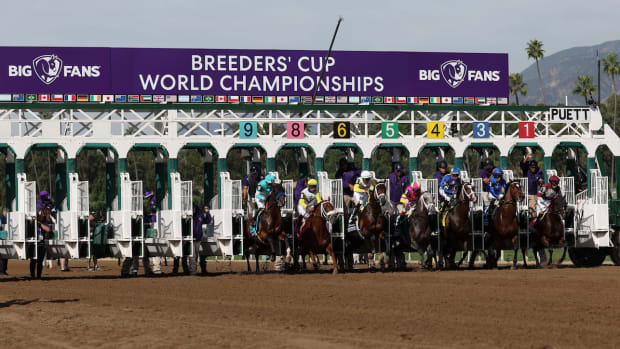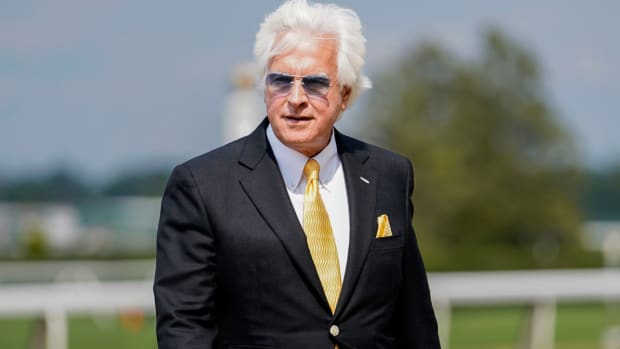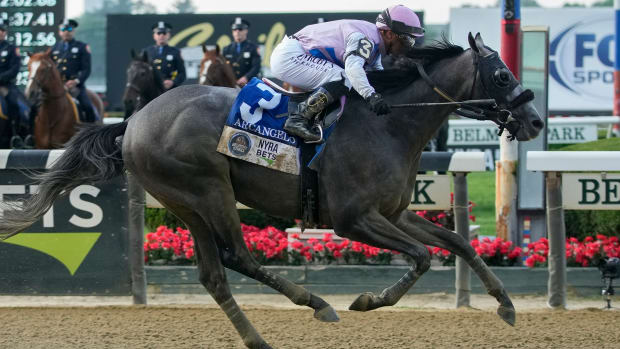State of the Stallion: Triple Crown Winner Justify's Retirement a Sign of the Times
Let’s start here before we get to the messy stuff, and before we slog together through a swamp of anger and disappointment directed at both old traditions and new normals in the beautiful and agonizing sport of thoroughbred racing. On the second Saturday in June of this year, 46 days ago, a chestnut-colored racehorse named Justify won the Belmont Stakes and become the sport’s 13th Triple Crown winner. He led for every step of the race’s endless 1 1/2 miles and finished 1 3/4 lengths in front of runner-up Gronkowski, although the outcome was not seriously in doubt at any point in the race, except possibly for dreamers and spoilsports. Justify became just the second undefeated Triple Crown winner, after Seattle Slew in 1977. More remarkably, he compiled his unbeaten record in six races over a breakneck 112 days, a feat of precocity that is unmatched in the sport’s history.
It had been only three years since American Pharoah won his Triple Crown, ending a 37-year drought between Triple Crown winners, a storyline that had both held racing hostage and defined it with a reliable narrative arc that became both more punishing and more dramatic with each successive Belmont Day failure. A sport was set free that day in 2015 and Belmont Park shook in celebration. It was unlike any sporting event I’ve witnessed or covered. We wondered if another one, so soon, would be as meaningful, and let’s be honest here: It wasn’t. But it was pretty damn good. The grandstand quivered again and the racetrack was awash in the powerful sensation that comes with witnessing history. As I wrote before the race, there is no duplicating the desperation that comes with waiting 37 years, but the Triple Crown is a singular accomplishment that defines itself. June 9 was a good day. A memorable day.
On Wednesday afternoon, to the surprise of no one remotely associated with the racing game, Justify was retired. He did not contest another race after winning the Belmont and joined Count Fleet (1943) as just the second of those 13 Triple Crown winners to retire without competing further. Ostensibly, Justify was retired because shortly after returning to his home base in trainer Bob Baffert’s California barn, he developed filling–swelling–in his left front ankle and had not been worked since the Belmont. The plan stated by majority owner WinStar Farm had been that Justify would race two or three more times, including a sendoff in the November Breeders Cup Classic at Churchill Downs, and then be retired. The ankle issue took Justify out of training too long for him to get fit, run a prep race or two and then reach the Breeders Cup in top form.
The operative word here is ostensibly. The explanation makes perfect sense as far as it goes: Baffert says Justify is hurt and has missed too much training to make the Breeders Cup with any certainty. But there’s a $60 million—at least—elephant in the stall: That’s the figure that Coolmore Stud has reportedly agreed to pay for the rights to Justify’s stallion career. It was a secret in plain sight long before the Belmont that Justify might never race again, because he is worth multiples more in the breeding shed than on the racetrack, and he could get injured—possibly fatally—on the racetrack.
This is not a new story in racing. If you’re feeling outraged today because this majestic animal will now spend his time in a big stall in Kentucky, getting hauled out three or four times a day during breeding seasons to impregnate mares, you haven’t been paying attention to the sport for the last half-century or so. (Also: Here is where you might feel compelled to post a pithy tweet about the love life of a stallion. Go right ahead, but try to be original. And let me add this: There’s a healthy debate in the racing industry about the practice of taking a three-year-old racehorse—a teenager in human terms—and tossing him into a routine where he breeds to as many as 200 mares a year in both hemispheres. It’s exhausting and, as it’s been explained to me, not nearly the dream lifestyle that it might seem to a sophomoric male with a keyboard or a smartphone. Anyway …)
The economics of racing almost demand that a healthy, accomplished colt be retired sooner than later. It’s an expensive game that bankrupts even wealthy people and if given a chance to cash out and turn a racehorse into an ATM, most people jump at that. Those economics are a painful reality for fans who simply love watching gifted racehorses, but they are as real as dirt beneath the hooves. Justify’s retirement will land especially hard for fans who remember that three years ago, American Pharoah came back after winning the Triple Crown to race three more times. First, he won the Haskell at Monmouth Park in New Jersey in late July of that summer; that old seaside track was alive that afternoon. Then he lost to Keen Ice in the Travers at Saratoga, but more memorable was that thousands of fans turned out to watch Pharoah gallop on the Friday morning before the race, an unprecedented day of worship at one of the sport’s true cathedrals.
And then on a grey, windy afternoon at Keeneland Race Course in Lexington, he toyed with the field and won the Breeders Cup Classic. It was a fitting and emotional coda to a historic career. Only the greediest among us were left wanting more.
But that was different. Pharoah was a valuable stallion, but his owner, Ahmed Zayat, had sold his breeding rights months before the Kentucky Derby, a hedge that left millions on the table that Zayat was trying to recoup at the racetrack. Still, Zayat also held breeding shares that generate millions; his decision to keep racing Pharoah was pragmatic, but also generous. Look at other examples. In 2004, Smarty Jones was an immensely popular horse who was beaten in the Belmont, and then never raced again. Likewise in 2005 with Afleet Alex a year later, after winning the Preakness and Belmont.
Others have carried on. Curlin was a brilliant three-year-old in 2007 and kept going. Secretariat was famously syndicated before winning the Belmont in 1973 and raced into the fall, even in the pre-Breeders Cup era. Seattle Slew and Affirmed kept going. Most recently, Gun Runner finished third in the 2016 Kentucky Derby but kept developing and for the latter half of 2017 was the best racehorse in the world. There are countless examples on both sides of this equation.
Here’s what’s potentially troubling with Justify: He is the best horse to arise in the burgeoning era of uber-ownership groups. Justify’s majority (60 percent) owner is WinStar, a Kentucky breeding farm that’s full of horse lovers but operates very much like a Fortune 500 business. Buy, race, sell. On Justify, they partnered with the fledgling China Horse Club, whose public face is Teo Ah Khing, a personable, unrevealing man fronting what remains largely a mysterious operation. There were two minority owners who do not have breeding rights and at least one ex-owner who does. WinStar had pieces of three starters in the Kentucky Derby and China Horse Club was in on two. There is a distinct sense that such groups will be an increasingly potent presence at the top levels of the game and they will make the decision that they made on Justify every single time. Buy, race, sell.
The math is relatively simple on this: If Justify stayed on the racetrack and won three more races, he could accumulate another $5 million or so in earnings. As a stallion, guessing conservatively, he might stand for a stud fee of $150,000 per mating, breed to 150-200 mares and generate somewhere between $22.5 million and $30 million per year (most of it for Coolmore). You can mess with the numbers, up and down, and that stud fee could drop in future years, but you will not get to a point where continuing to race makes financial sense. It just doesn’t. The exceptions will come only if the owner of super-horse du jour is a wealthy philanthropist of the type that once dominated the game. That guy, or that woman, might choose to keep a great horse on the racetrack, for the people, because they already have plenty of money and why not take the risk for the love of the game.
(You could also argue here that WinStar and Coolmore have plenty of money, too, and you would not be wrong. Good luck making that argument).
One other thing: I believe that Justify has some sort of injury. Four days after the Belmont I was texting back and forth with Baffert.
Me: “I hope he runs a couple more times.”
Baffert: “He will.”
So there is that.
But here’s another approach: Let it go. And ask yourself a question: Putting aside your anger at the institutional greed that envelops great racehorses, what more did you want from Justify? This is what he gave us: The most mind-boggling rush to greatness imaginable— 112 days from a maiden race to a Triple Crown. He gave us a wire-to-wire Kentucky Derby victory in the slop, ending the Apollo Curse, and then dug down to win the Preakness, emerging from clam chowder fog (apologies to pea soup, but let’s give some other dense liquid a shot here) to win when he wasn’t at his best.
And then he ran into history in the Belmont Stakes. He was supposed to get tired, but he didn’t. He was supposed to wear down from the compressed schedule, but he didn’t. He was supposed to lose. But he didn’t.
Some will argue that two or three more races for Justify would have been good for the sport. Please. American Pharoah’s Haskell, Travers and Breeders Cup were good for the sport, sure, but it was fleeting. Nothing changed. Horse racing still has problems that won’t be solved by any one horse. Fans who make this argument are as selfish in their own way as WinStar and Coolmore in theirs. (And don’t get me wrong. If Justify had kept racing, I would have been there with my laptop and lots of fresh adjectives at the ready. Sign me up.) But peak American Pharoah happened on Belmont Day; the rest was a long encore. Peak Justify happened on Belmont Day, too. We were lucky to have him, even for just six races.
Remember that. Embrace that. Hold that. Let the rest of it go, at least for a day.





